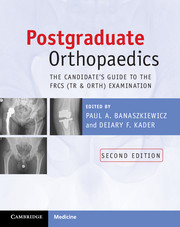Book contents
- Frontmatter
- Contents
- Contributors
- Foreword
- Preface to second edition
- Abbreviations
- Section 1 The FRCS (Tr & Orth) examination
- Section 2 The written paper
- Section 3 The clinicals
- Chapter 3 The short cases
- Chapter 4 The intermediate cases
- Chapter 5 Shoulder and elbow clinical cases
- Chapter 6 Hand and wrist clinical cases
- Chapter 7 Spine clinical cases
- Chapter 8 Hip clinical cases
- Chapter 9 Knee clinical cases
- Chapter 10 Foot and ankle clinical cases
- Chapter 11 Paediatric clinical cases
- Section 4 The adult elective orthopaedics oral
- Section 5 The hand oral
- Section 6 The paediatric oral
- Section 7 The trauma oral
- Section 8 The basic science oral
- Section 9 Miscellaneous topics
- Index
Chapter 3 - The short cases
from Section 3 - The clinicals
- Frontmatter
- Contents
- Contributors
- Foreword
- Preface to second edition
- Abbreviations
- Section 1 The FRCS (Tr & Orth) examination
- Section 2 The written paper
- Section 3 The clinicals
- Chapter 3 The short cases
- Chapter 4 The intermediate cases
- Chapter 5 Shoulder and elbow clinical cases
- Chapter 6 Hand and wrist clinical cases
- Chapter 7 Spine clinical cases
- Chapter 8 Hip clinical cases
- Chapter 9 Knee clinical cases
- Chapter 10 Foot and ankle clinical cases
- Chapter 11 Paediatric clinical cases
- Section 4 The adult elective orthopaedics oral
- Section 5 The hand oral
- Section 6 The paediatric oral
- Section 7 The trauma oral
- Section 8 The basic science oral
- Section 9 Miscellaneous topics
- Index
Summary
Having spoken to over 50 candidates about their experience in the short cases, many regard this as the most difficult part of the FRCS (Tr & Orth) examination. Simply, you have very little time to show the examiners your competence with each particular diagnosis. Examiners often say that there are few surprises in the short cases as a ‘rheumatoid’ or ‘Dupuytren's’ hand is certain to be present in the examination hall. This is often true, but unfortunately you may not see any of these cases and therefore cannot simply learn these two diagnoses! There are also a number of more complex cases and these can catch you out if you are not familiar with them. First you must be able to confirm the diagnosis and secondly be able to talk around the topic. If you have nothing at all to say to the examiners, it makes it very difficult to achieve that pass.
The new format of the short cases exam is divided into upper and lower limb sections. These last for 15 minutes each but have the same pair of examiners. You will generally see only three cases each for upper and lower limb, having approximately 5 minutes for each. At 5 minutes you move onto the next case, so if you know nothing about the diagnosis it's going to be a long 5 minutes. There is a random allocation of short cases, although in fairness there is usually a balanced mix of cases.
- Type
- Chapter
- Information
- Postgraduate OrthopaedicsThe Candidate's Guide to the FRCS (Tr and Orth) Examination, pp. 17 - 20Publisher: Cambridge University PressPrint publication year: 2012



